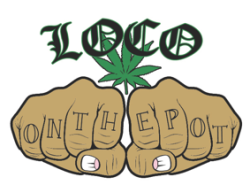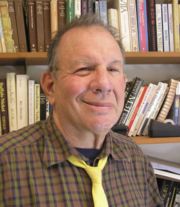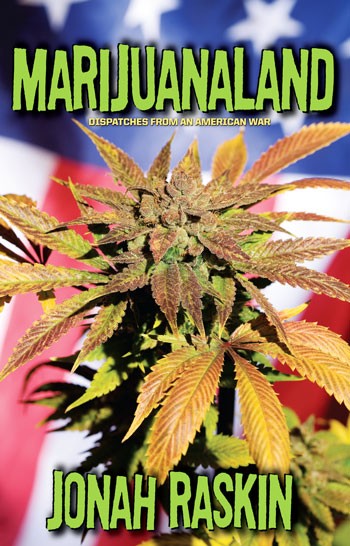
My buddy Jonah Raskin has written about cannabis since the 1970s. His most recent work on the subject is Marijuanaland: Dispatches from an American War, published by High Times, and in France by Les Fondeurs du Brique. He also created the story and the characters for the Hollywood pot movie Homegrown.
Marijuanaland was published in 2011. It’s like this noir odyssey into the Emerald Triangle and it features many familiar characters, including LoCO’s own Kym Kemp. The book, as noted above, was recently released in French, and Jonah hopped the pond in December to do a book tour in France.
Jonah was kind enough to share this essay about his experience talking cannabis in France. Turns out, there are French folks that are fascinated with marijuana and the Emerald Triangle. And you wonder why we get trim tourists. Check this out, it’s a good read. Jonah is a totally badass and accomplished weed writer. He offers a unique perspective.
I also want to point you to his August 2013 interview with Jorge Cervantes, the legendary author of Marijuana Horticulture, the “bible” of growing weed. It’s a good read as well. —Emily Hobelmann
———-

France and the French are on the cusp of a cannabis revolution, and, while they’re still woefully behind their European neighbors, the Dutch and the Spanish, they’re quickly catching up. In December 2013, I caught up with the French cannabis scenes, meet cannabis users, cannabis growers and dealers, most of them clandestine. Nobody is really out of the closet there. As a country, France doesn’t recognize medical marijuana. As a country, the French associate cannabis, and specifically hash, with North Africa, and that means there’s an element of race and racism in the French cannabis scene.
But there’s also a new savvy generation of young Frenchmen and French women who aren’t manipulated by all the old lies and untruths and who are open to new ideas about cannabis. I was impressed by their willingness to craft a cannabis culture for the needs and the wants of France and not just borrow from the U.S., Holland and Spain. That makes sense to me.
For three weeks, I also talked about cannabis in America, and specifically in California where I’ve lived since the 1970s. I wanted to provide the French with a crash course in American cannabis, hoping that our past might in some way guide their future. Mostly young people showed up to hear me speak. They were curious; they wanted to learn. I felt the need to compress our history, to present clear lines and to include facts and names without getting lost in smoke.
When I looked back and thought about history, it seemed to me that for the past eighty or so years, cannabis law in the U.S. has run woefully behind cannabis customs and culture. The cannabis farmer, distributor and consumer has managed to stay a step or two ahead of the narcotics cop — with a lot of ingenuity and a bit of luck. Perhaps that’s why the law in the U.S. has operated so vindictively, so senselessly and so ineffectively for decades.
What Americans often forget or never knew, is that cannabis was legal for more than a hundred years. They don’t remember that American doctors prescribed it and that American pharmaceutical companies manufactured it. In fact, cannabis didn’t become illegal by federal law until the Great Depression — in 1937 precisely — when Franklin D. Roosevelt was president and Harry Anslinger, the first “drug czar,” turned marijuana into a dirty word.
The prohibition of “pot,” as it came to be popularly known in the 1960s, replaced the failed Prohibition of alcohol that bred gangs, gangsters, G-Men and millions of gallons of cheap booze. The arrests haven’t stopped, not since 1937. Narcotics agents, though they’re often flat footed, do manage to catch up with dealers and growers before cannabis consumers, connoisseurs and commercial operators elude them once again in a kind of comic book scenario that isn’t funny for those who find themselves handcuffed and behind bars.

What really gets me, and what I can’t get over is that over the past half-century, as many as 50,000,000 Americans have been detained by the police and booked for violations of the law, many of those millions for possession of small amounts. The cannabis growers, sellers and smokers provide the necessary bodies to keep the insane system of prohibition running uninterrupted, with the help of police, judges, prisons, prison guards, probation officers and researchers who try to show over and over again that cannabis is a dangerous drug — worse than heroin, according to the federal government — that it causes irreparable harm to the individual and to the society as a whole. No wonder that critics of marijuana law call the system that has operated here since 1937 “Reefer Madness.” It’s crazy and crazy making. You have to work not to let it get to you.
Changing old habits and outmoded ways of thinking has come slowly, but also dramatically. Hippies smoked pot en masse in the 1960s and 1970s in communes and at rock festivals like Woodstock, adopting a custom long practiced in black and Latino communities and by artists and actors such as trumpeter and crooner Louis (Satchmo) Armstrong and tough guy screen star, Robert Mitchum, who mocked his own arrest and the accompanying publicity as though playing a role in one of his own movies — Out of the Past, for example.
The biggest legal change, as most of us know by now, came in 1996 when California voters approved a measure permitting cannabis for medical reasons, specifically for those in pain and suffering from HIV, AIDS, cancer and cancer treatments — setting off heated conflicts between the state of California and Washington, D.C. and between and states’ rights and federal law. At times, it looks as though the states are winning, and at other times, it seems that the feds have the upper hand, especially when they go on a rampage and shutter dispensaries.
Since 1996, 19 states across the country and the District of Columbia have followed California’s example and adopted similar marijuana measures — with Colorado and Washington entering new territory by approving the smoking of marijuana for pleasure and for recreation. Hey, it’s a brave new world out there.
One wonders what, if anything, France and the French can learn from the American love/hate relationship with cannabis that divided generations in the past, and that divides the nation itself these days. First, I think, the French will have to recognize that cannabis is widely consumed in France and that cannabis consumption is on the rise, especially among the young — and not just among North Africans.
Second, the country will need to reject the idea that cannabis is noxious and begin to accept the growing body of scientific information that shows that it’s a beneficial medicine. Third, France will probably have to reorder its priorities and realize that arresting and jailing people for possession of marijuana is a waste of valuable taxpayer money, time and manpower. The cannabis activist I recently met would probably all endorse those ideas.
If France is to legalize cannabis, it will also mean standing up to Washington, D.C. and the White House, which has long imposed its rigid policies about cannabis on the rest of the world, even as American agencies such as the CIA have aided and abetted drug traffickers pushing heroin and cocaine from Laos to Colombia. American hands are dirty all over the world.
Hypocrisy is probably the last thing that France needs if it is to address the issue of cannabis, and hypocrisy is not easily overcome, as I know from my own experience as a journalist in California, beginning in 1980 and coming up to the present day. On and off for more than thirty years, I have watched the Golden State as cannabis has moved from backyard hippie gardens to fields and greenhouses, from the margins of society to Main Street, and as the authorities have thrown men, materials and money at a phenomenon that has been called the “New Gold Rush.” From all over the world, immigrants have arrived in California in droves to grow “weed” in the mountains, as they once arrived to dig for gold.
In the 1980s, when the Reagan administration ramped up the drug war and the president’s wife, Nancy, urged Americans, “Just Say No,” marijuana culture boomed in counties that came to be known collectively as “The Emerald Triangle” — an area about the size of many states in the United States, such as Massachusetts. Not everyone grows marijuana in Humboldt, but it often seems that way. At a party on New Year’s Eve I happened to mention to a woman sitting next to me at the dining room table that, in my opinion, not everyone in Humboldt grows marijuana.
Before she could answer, the host of the party said, “That’s true, but almost everyone in Humboldt knows someone who is growing marijuana and everyone in Humboldt benefits directly or indirectly from the cannabis economy.” I know that from my experience as a reporter: no town or city, big or small in Humboldt, is untouched by cannabis dollars, whether they infuse the black market or the legitimate economy.
The French find our recent history amazing and entertaining. Very few of them have ever been to Humboldt, though they have seen photos and movies about the Emerald Triangle. To the French, the story of California marijuana is a bit unreal — as unreal as Hollywood itself.
Well-informed Frenchmen and women know that in the 1990s, marijuana cultivation moved from the outdoors to indoors with artificial lights and state of the art technology in part to hide from the police, but also to grow more potent strains and to be able to harvest crops three times a year, not once.
The “greed weed” morphed and then morphed again. Sometimes it was a challenge to keep up with it. Mexican cartels, which had smuggled marijuana into the U.S. for years, began to grow marijuana inside the U.S., often in federal forests, where it was easier to hide than in the open, and where they often caused severe environmental damage. Ecologists have been rightly outraged and have launched campaigns to clean up the messes created by cartel members and others.
In the 2000s, big changes occurred when doctors all across California — and in other states — began to recommend cannabis to their patients. Thousands of dispensaries that sold dozens of varieties of cannabis with varying degrees of strength, popped up from Los Angeles to San Francisco and from Seattle, Washington to Denver, Colorado. Out-manned, out-foxed, and out-flanked, the federal government has just recently begun to back down, giving way to the states, and yet is still unwilling to wave a white flag and surrender to the cannabis cause. In a war, no one likes to admit defeat, but it has become increasingly difficult for drug czars and drug warriors to save face.
My French friends tell me that there’s a great deal of information in French, much of it conflicting on the subject of marijuana and that it’s difficult for French citizens to sift the facts from the fictions. One recent book, Le Cannabis?, (2013) tries to give the impression of objectivity, but the authors are clearly prejudiced. Even moderate Americans — Libertarians, Democrats and some Republicans — would find it misguided at best, misinformed at worst, especially when Daniele Jourdain Menninger writes in the Preface to the book that, “Cannabis is not an innocent, convivial drug as some like to believe, but a drug with noxious effects.” A great many American doctors would strongly disagree.
Perhaps what France needs most of all now is an end to lies, lying and propaganda. The French need access to clear, accurate information about the benefits as well as the dangers of cannabis. Hey, it’s not for everyone. Heaps of valuable books, articles and videos exist, some of it already in French and widely accessible.
To French audiences I would quote the American writer Raymond Chandler — author of The Big Sleep and other noir novels — who once wrote, “Marijuana affects different people differently.” I would also say to the French that it’s probably not a good idea for twelve and thirteen year-olds to smoke cannabis, much as it isn’t a good idea for them to smoke cigarettes.
The French are still smoking tobacco; they roll their own cigarettes. In France, a common way to smoke pot is to smoke it with tobacco. They don’t have large amounts of weed; they don’t have big buds and the pot doesn’t have the THC levels that you can find in the Emerald Triangle.
What makes me sad and angry, I told the French, is not only that hundreds of thousands of Americans are arrested for pot every year but that the American government has lied and still lies to the American people about cannabis for decades with so-called experts insisting that smoking a joint leads to murder, mayhem and madness. The lies have come back to haunt Washington.
Ever since the 1960s, every single generation and millions of Americans have learned that the official story just isn’t true, that, in fact, cannabis can make life more pleasurably and less painful and that one can smoke marijuana and still be a responsible citizen and consumer, a good dad, a good mom and a taxpayer, too.
Apparently, the majority of Americans now agree that the war against marijuana is far more harmful to society as a whole than the consumption of marijuana. That’s what the polls say. Perhaps France might speed up their crash course in cannabis and not wait as long as we have had to wait in the U.S. Perhaps the French might not incur the terrible social costs of a war that has contributed to the destruction of families and communities.
These days, increasing numbers of young Frenchmen and women — and not so young Frenchmen and women — consume homegrown marijuana and homemade hashish. Some of it has toxic chemicals and impurities. For their health and for the health of French society, decriminalization and legalization both look like positive alternatives to the present situation in which scoundrels and cutthroat criminals take advantage of the Prohibition for profit and power. When scoundrels rule, whether in France or in the United States, they contribute to the collective sense of stress and frustration, and citizens like you and like me pay a heavy penalty.
I told the French that I was optimistic and hopeful. I told them, too, that it had taken us a long time for America to get into the cannabis mess and that it would take time to get out of it. But if citizens of the Emerald Triangle had figured out how to grow the best cannabis in the world, surely they could also figure out a better model than the model of law enforcement that it has today. Whatever happens, it isn’t going to stay the same. After thousands of years of co-evolution, cannabis and human beings will go on evolving together for better or for worse, for pleasure or for pain, for freedom or for bondage.
— Jonah Raskin
CLICK TO MANAGE